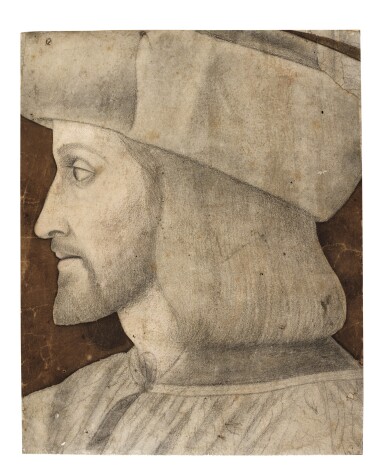
Milanese School, circa 1515
Auction Closed
January 27, 05:29 PM GMT
Estimate
30,000 - 40,000 USD
Lot Details
Description
Milanese School, circa 1515
Portrait of a man seen in profile wearing a hat
Black chalk, with later brown wash; bears inscription in brown ink, verso: L...ontio ...lin..i
264 by 212 mm; 10 ⅜ by 8 ⅜ in
This refined portrait of a man was most probably once part of a group with six other very similar studies, five of noblemen and one a noblewoman, now in the Accademia Carrara in Bergamo.1 These drawings, all profile portraits, came from the collection of Giacomo Carrara (1714-1796), a passionate collector and ‘erudite’ from an aristocratic family in Bergamo, who collected extensively between 1760 and 1790. This group, most probably the work of one master, has attracted the interest of several scholars and has been the subject of considerable art historical debate.2Until now, no satisfactory attribution has been put forward, nor have any of the sitters been identified; the master who made these delicate and elegantly drawn portraits remains to be discovered. A dating of circa 1515 has, though, been generally accepted by scholars.
Like the Carrara group, the present sheet is a rare testimony to the tradition of portraiture, strictly in profile, favoured from the early 15th century in the artistic centers of Milan and Lombardy, which followed in the wake of Leonardo. Very few of these portraits have, though, survived.
In 1796, at the death of Giacomo Carrara, the group now in the Accademia Carrara was listed in the inventory prepared by Carrara’s restorer Bartolommeo Borsetti as the work of Leonardo da Vinci 'li ritratti di Leonardo da Vinci', as was first noted by Ragghianti in 1963.3 The first scholar to associate the group with the artistic center of Milan, and with painters like Andrea Solario (1460-1524) and Bernardini de' Conti (1496-1522), was Augusto Frizzoni.4 This view was shared by Malaguzzi Valeri, who placed the group in the same cultural context when discussing the artistic personalities of the earliest court portraitists of the Sforza in the Quattrocento (such as Zanetto Bugatto and Bonifacio Bembo).5 Moreover Malaguzzi Valeri proposed to identify one of these portraits, the Man with a necklace and a cap (Accademia Carrara, inv. no. 1998), with Filippo Maria Visconti, a suggestion that has found no support from others.6
More recently, Giulio Bora, studying a fascinating portrait by Bernardino Luini (1480-1532) of Biagio Arcimboldo (father of the painter Giuseppe Arcimboldo), has pointed out stylistic similarities with the draughtsman of the Carrara group.7 The Arcimboldo portrait, in the British Museum, is executed in the same media and has a similar dark washed background, though is generally very typical of Luini’s graphic style. Another portrait that has also been associated in the past with the Carrara group is the large scale drawing, Head of a Man, given to Bernardino de' Conti (1450-1525), formerly in the Sonnenberg and Woodner collections.8 Now in the National Gallery of Art, Washington, this drawing was assigned to a variety of Milanese masters, and finally attributed to Bernardino de' Conti by Karl Parker in 1927, on the basis of close similarities with a signed and dated 1499 portrait of a Cardinal in the Gemälde Galerie, Berlin. 9 This large drawing is executed mostly in black chalk with touches of red, and again like the Carrara group and the present sheet is testimony to the same tradition, but like the British Museum sheet, bears no more specific stylistic resemblance to the master of the Carrara drawings and the present work.
Though its authorship remains for now a mystery, this fine, sensitively drawn portrait is a rare surviving example of an important early 16th-century tradition of portrait drawing, as well as a touching record of the unknown gentleman that it depicts.
1. Bergamo, Accademia Carrara, inv. nos. 1993 to 1998.
2. For a summary of the various opinions put forward by different scholars, see, Maria Teresa Fiorio, Grafica del '500,2, Milano e Cremona, exh. cat, Bergamo, Accademia Carrara, 1982, pp. 9-14, nos 1-6, reproduced
3. Archives of the Accademia Carrara, mss c.97; C.L. Ragghianti, Antichi disegni e stampe della Accademia Carrara di Bergamo, exh. cat., Bergamo 1963, p. 3
4. G. Frizzoni, La Galleria della Accademia Carrara in Bergamo, Bergamo 1907, p. 19
5. F. Malaguzzi Valeri, 'Maestri minori Lombardi del Quattrocento,' Rassegna d'Arte, XI, 1911, p. 195
6. In the late 1970s Ragghianti proposed for the only female portrait in the group (Accademia Carrara, inv. no. 1994) a close relation to a series of portraits of noblewomen in the 'Libro' of Ambrogio Noceto, datable to 1518-1521
7. London, British Museum, inv. no. 1895,0915.767; see, G. Bora, 'La prospettiva della figura umana, gli ''scurti'', nella teoria e nella pratica lombarda del Cinquecento, La prospettiva rinascimentale. Codificazioni e Trasgressioni.Atti del convegno, Florence 1977, p. 14
8. Washington, D.C., National Gallery of Art, inv. no. 1998.17.6
9. K.T. Parker, North Italian Drawings of the Quattrocento, London 1927, no. 68, reproduced pl. 68
